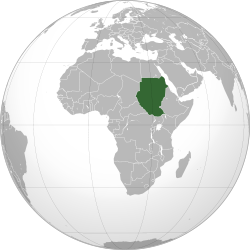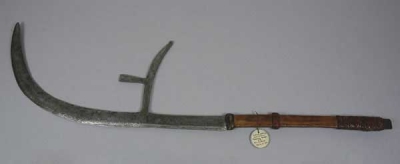Zungan dowi (1954.5.74)
 SudanZungan dowi from Sudan, Africa. Collected by Anthony Arkell between 1934 and 1936. Given to the Museum in 1954.
SudanZungan dowi from Sudan, Africa. Collected by Anthony Arkell between 1934 and 1936. Given to the Museum in 1954.
This is a zungan dowi or 'cocks-tail' form of throwing-knife from Dar Masalit, a small state established in the Darfur region of western Sudan in the 19th century. For obvious reasons, this weapon is also known as an 'F-shaped' throwing knife, which the Masalit people often used for ceremonial purposes. The underside of the inner spur is blunt, enabling it to be carried over the shoulder.
Warrior Elites
Early scholars remarked on the functional use of throwing knives as ingenious weapons developed by Africans from the throwing stick (the two weapons have a broadly similar form and ancient examples of the latter have been discovered in Egypt). It is said they were used by skilled indigenous warriors to cut the legs of horses and infantrymen and thereby counter the armed cavalry of Arabic invaders during the period 1000-1500 AD. While this suggestion is fairly plausible for Darfur and other eastern areas where the throwing knife occurs, Chris Spring of the British Museum has questioned this origin for throwing knives further west, where cavalry were largely absent.
Darfur throwing knives appeared in a number of social and cultural contexts other than warfare. Perhaps most notably, they were important political symbols of the Darfur Sultanate of Darfur until the 1870s when the kingdom fell to Egyptian rule. They were carried in processions by warrior-slaves of the Sultan of Darfur (known as samballang or 'throwing-knife men'), as an important part of his state regalia. Similarly, when the Sultan went to hunt, they were carried before him. This symbolism may reflect an ultimate origin for the throwing knife as a hunting, rather than an anti-cavalry, weapon. If the link to throwing sticks is a valid one, this also implies an origin as a hunting tool.
These weapons were also carried by fiki (Koranic scholars) as a badge of their exalted status. In the later 19th century, zungan dowi were carried by young men at mixed-sex dances to impress their martial qualities on unmarried women, although they were later replaced by kaskara broadswords, and then muskets, as symbols of warrior-masculinity.




